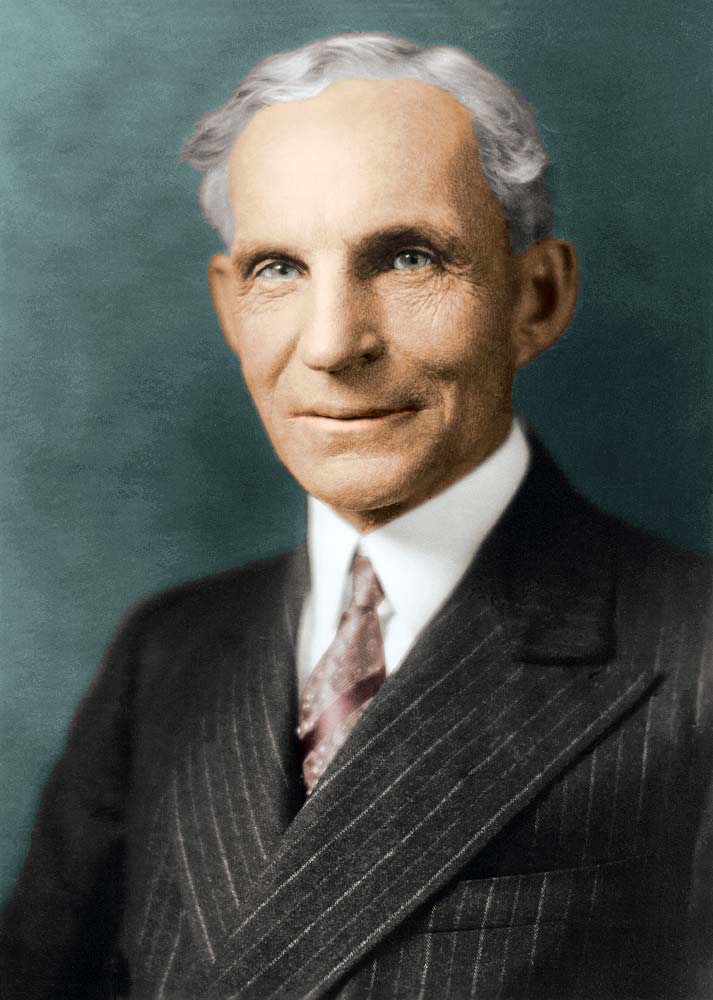|
Henry Ford
Henry Ford, born on July 30,
1863, was the first of William and Mary Ford's six children. He grew
up on a prosperous
family farm in what is today Dearborn, Michigan. Henry enjoyed a
childhood typical of the rural nineteenth century, spending days in
a one-room school and doing farm chores. At an early age, he showed
an interest in mechanical things and a dislike for farm work.
In 1879, sixteen-year-old Ford left home for
the nearby city of Detroit to work as an apprentice machinist,
although he occasionally returned to help on the farm. He remained
an apprentice for three years and then returned to Dearborn. During
the next few years, Henry divided his time between operating or
repairing steam engines, finding occasional work in a Detroit
factory, and over-hauling his father's farm implements, as well as
lending a reluctant hand with other farm work. Upon his marriage to
Clara Bryant in 1888, Henry supported himself and his wife by
running a sawmill. apprentice machinist,
although he occasionally returned to help on the farm. He remained
an apprentice for three years and then returned to Dearborn. During
the next few years, Henry divided his time between operating or
repairing steam engines, finding occasional work in a Detroit
factory, and over-hauling his father's farm implements, as well as
lending a reluctant hand with other farm work. Upon his marriage to
Clara Bryant in 1888, Henry supported himself and his wife by
running a sawmill.
Ford became an engineer with the Edison Illuminating Company in
Detroit. This event signified a conscious decision on Ford's part to
dedicate his life to industrial pursuits. His promotion to Chief
Engineer in 1893 gave him enough time and money to devote attention
to his personal experiments on internal combustion engines.
These experiments culminated in 1896 with the completion of his own
self-propelled vehicle-the Quadricycle. The Quadricycle had four
wire wheels that looked like heavy bicycle wheels, was steered with
a tiller like a boat, and had only two forward speeds with no
reverse. Although Ford was not the first to build a self-propelled
vehicle with a gasoline engine, he was, however, one of several
automotive pioneers who helped this country become a nation of
motorists.
Ford Motor Company Incorporated and the Introduction of the Model
T After two unsuccessful attempts to establish a company to
manufacture automobiles, the Ford Motor Company was incorporated in
1903 with Henry Ford as vice-president and chief engineer. The
infant company produced only a few cars a day at the Ford factory on
Mack Avenue in Detroit. Groups of two or three men worked on each
car from components made to order by other companies.
Henry Ford realized his dream of producing an automobile that was
reasonably priced, reliable, and efficient with the introduction of
the Model T in 1908. This vehicle initiated a new era in personal
transportation. It was easy to operate, maintain, and handle on
rough roads, immediately becoming a huge success. By 1918, half of
all cars in America were Model Ts. To meet the growing demand for
the Model T, the company opened a large factory at Highland Park,
Michigan, in 1910. Here, Henry Ford combined precision
manufacturing, standardized and interchangeable parts, a division of
labor, and, in 1913, a continuous moving assembly line. Workers
remained in place, adding one component to each automobile as it
moved past them on the line. Delivery of parts by conveyor belt to
the workers was carefully timed to keep the assembly line moving
smoothly and efficiently. The introduction of the moving assembly
line revolutionized automobile production by significantly reducing
assembly time per vehicle, thus lowering costs. Ford's production of
Model Ts made his company the largest automobile manufacturer in the
world.
The company began construction of the world's largest industrial
complex along the banks of the Rouge River in Dearborn, Michigan,
during the late 1910s and early 1920s. The massive Rouge Plant
included all the elements needed for automobile production: a steel
mill, glass factory, and automobile assembly line. Iron ore and coal
were brought in on Great Lakes steamers and by railroad, and were
used to produce both iron and steel. Rolling mills, forges, and
assembly shops transformed the steel into springs, axles, and car
bodies. Foundries converted iron into engine blocks and cylinder
heads that were assembled with other components into engines. By
September 1927, all steps in the manufacturing process from refining
raw materials to final assembly of the automobile took place at the
vast Rouge Plant, characterizing Henry Ford's idea of mass
production.
Return to
List
Home Page |

